I have three weaknesses. You’ve already figured out the embroidery one – I’m a bit obsessed with needle & thread. But you might not know about the other two, which are closely connected. One is old books and the other is children’s books.
Imagine all three of those woven together into one book – a book I grew up with.
And that’s where this book fits in. How a Shirt Grew in the Field is a children’s book that, in storybook fashion, takes the child (and adult!) through the whole process of how linen was made by the Russian peasant back in the days before industrial farming and textile machinery. In the late ’60’s, Marguerita Rudolph adapted the original Russian tale by Konstantin Ushinsky (the original story is over 140 years old), and Yaroslava, a Ukrainian folk artist and illustrator, drew the illustrations. The book has since been republished (in the ’90’s) and re-illustrated by Erica Weihs. Both editions are out of print but available through used book sources or libraries.
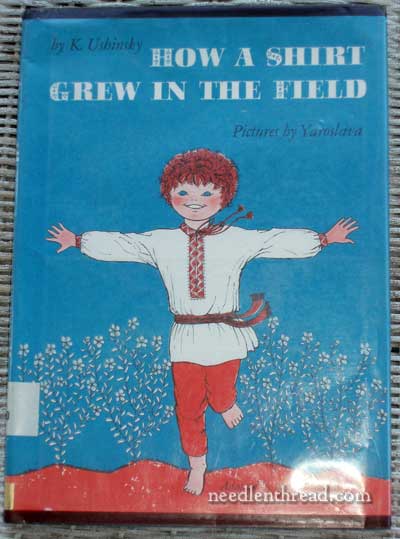
The story begins with a young boy, Vasya, who watches his father planting seed by hand in a field. He asks his father what he is doing, and his father tells him that he is sowing flax seeds so that a shirt will grow for Vasya and his little sister.
Well, this intrigued the little lad. How can a shirt grow in a field?
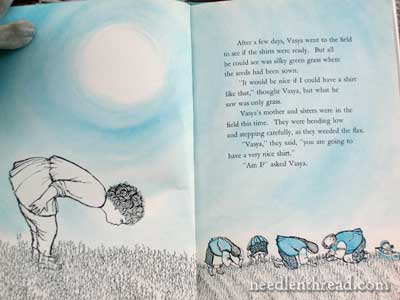
Vasya observes all that happens with this field – he sees his mother and father and older sisters weeding the field, then he sees the field blossom with beautiful blue flax blossoms. He watches as the field is cut down. And all the while, he is puzzled, because he doesn’t understand how a shirt will grow there.
The tale takes the reader through the harvesting of the flax, the winnowing of the flax, the soaking of the flax stalks in the river…
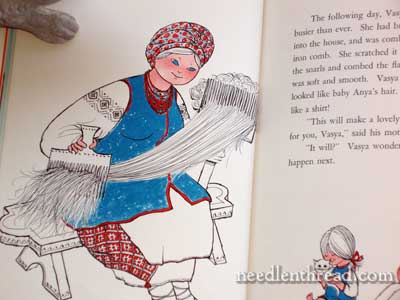
… eventually, the combing of the flax, the spinning of the flax tow into thread, the weaving of the thread into cloth, and then the whole process to make the cloth soft and white – how they spread it out in the snow of winter, and then again on the fresh grass in the spring sun.
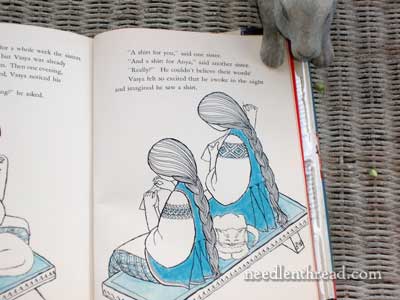
The cloth, now soft and white, is cut, and Vasya’s sisters begin adorning the various pieces with embroidery.
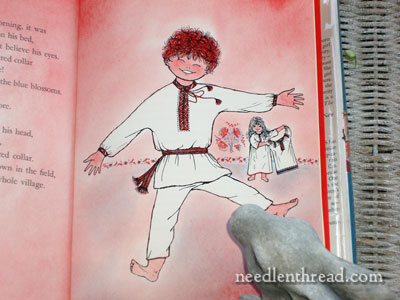
He awakens one morning to see his new shirt ready for him – and now he understands how a shirt can grow in a field.
In these days of practically-disposable clothing and cloth that is bought readily off the bolt, this book is a great little lesson for children to see the time-intensive and laborious process of creating cloth and clothing before industrialization. It gives them a peek into life 150 years ago and a little vicarious experience of what life then would have been like – imagine waiting a year or longer for a shirt! It’s a great way to inspire appreciation for the process and art of cloth making, as well as an appreciation for things.
It’s a great little book – for children… and adults!
So, why am I bringing up a children’s book? Well, last week, I was communicating with Jan of Wooly Thread, and she mentioned the book. Little did she know that I’ve a bit of an infatuation with these types of books – vintage, children’s, and textile-related – so her reminder was much appreciated! It was one of those little serendipitous memory jogs (thanks, Jan!). I always take delight in re-reading books I grew up with. And since I found it so delightful to revisit this gem, I thought you might like it, too!







Good morning, Mary,
What a delightful story! I, too, like old books as well as children’s books that tell a good story or that teach something. I’ve collected quite a few that way. I also like the old pop-up books–I find them “magical,” even at my age!
Thank you for sharing this beautiful story. It made my day! May yours be a good one also.
Doris Hernandez Huston
Mary–Thanks for posting about this book. Is this a good time to mention Russian charts freely available at http://patternmakercharts.blogspot.com? There may be some at antique pattern library as well. Russian & Eastern European ethnic motifs are very distinctive.
What a beautiful story about a story about the story of linen. I enjoyed that. Thank you!
I read for Librivox, a web based org that is in the midst of attempting to get all public domain books (ones that the copy right has run out) to the public for free. If you go to Project Gutenberg and look up “crafts” there are lots of needle work books, all free, public domain books, pics and all. There are books for everyone who likes to read or listen on there!
A beautiful story and a novel way of educating children. Thanks
What a delightful story!
Thank you for sharing.
I also love looking at old books. They are an instant transportation to another age 🙂
Thank you, Mary, it looks like a delightful book. And turning flax into fabric looks arm-breaking from that picture! It’s amazing how much we’ve forgotten; how much time actually goes into making fabrics, food and other basics.
Ah, that explains why I like your blog so much! I’m in the process of stitching some of the illustrations from The Phantom Tollbooth and if I had time would do all my favorite children’s books. Looks like some of the illustrations in The Shirt book above would be lovely stitched as well – would love to see your stitched version (hint!).
wow! this is sooo up my alley! Thanks for the heads up! I’m going to find a copy for my nieces one of whom is actually studying textiles in her third grade class right now! I’m supposed to go speak to the class (I’m a textile designer) and have been at a loss as to what I should talk about– maybe I could bring this book in!
We’re on the same page about needle, thread and books! I just ordered this book and one called “A New Coat for Anna” which is about a post WWII girl whose mom saves for wool, a weaver and a tailor to get her a coat. I can’t wait to share these with my granddaughter in a couple of years. (She’s only one now.)
Thank you so much for sharing this Mary – you have made my day! Its lovely to know that I can come onto your site on any day and just know that I will be leaving with a smile. Yet another fabulous post – thank you again!
Wish I had known about this book when I was teaching preschoolers! I would have searched for a copy to share with my students. Now I’ll have to search for a copy just so I can enjoy it myself.
So I was reading about Duchess Kate’s gown and thought it gave a nice shout out to the embroiderers at RSN. What an honor that must have been. can you imagine telling your grandchildren that you made the veil for a princess to be? The veil is long, sheer, and modern. It showcases her hair, which she is wearing down. The veil is made of layers of soft, ivory silk tulle with a trim of hand-embroidered flowers, which was embroidered by the Royal School of Needlework.
G’day Mary, Like others, these 3 things are so ‘me’. And I love this book. Will we all have our DNA compared?! Leave well enough alone eh. No mystery = nothing for the imagination to keep the brain in good humour.
Our local library regulaly sells off books, incl kids books. I’ve purchases a lot that my boys (and I) loved when they were little (25+ yrs ago!). Excitement for all of us when I find another favouite. Some are a bit knocked about but that just means they have another story to tell as well. All the kids books are only 20c. The granddaughter enjoys them now too, especially when Daddy reads them to her. She turned 2 Easter Sat.
Cheers, Kath.
Even thought this article was published almost 4 years ago, I am glad that I found it. Thanks for writing it. This same technique was done not that long ago in the area where I was born up to 60-70’s. The only difference is that they used to grow hemp for this purpose. My grandmother was doing this and she is 80 years old. We were affected by war and lost everything but somehow some pieces of the fabric survived and I have two pieces of it. One is softer and thicker and it used to serve as a bag for wheat or flour. The other one is not as soft as the first one and a little bit thinner and it was used as a bed linen. I still remember these kind of bed linens on my great grandmother’s bed. On both pieces there is one small hole which I am trying to figure out how to repair. One piece my mother embroidered with Christmas motifs so it will be used only once a year as a table decoration and the other one I will embroider with Easter motifs. They should keep sturdy at least my lifetime to keep my mother and grandmother in memory. Thanks again for wonderful article. Your site is great and helpful!